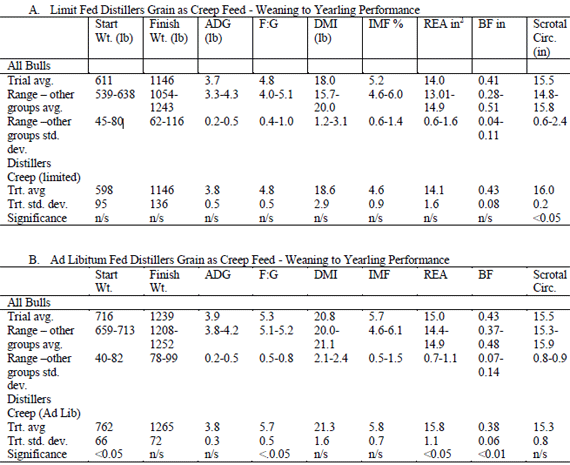



DDGS as Creep Feed for Calves
Dried distillers grains is a readily available commodity in Iowa that can be successfully used as a single ingredient creep feed for young suckling calves when considering both short term and long term results, writes Garland Dahlke and Daryl Strohbehn from Iowa Beef Centre.Introduction
Dried distillers grains is a feedstuff that is nutrient dense in terms of energy and protein. The energy component is derived primarily from fat and highly digestible fiber. The protein fraction also contributes to this energy pool, but is of high quality providing a source of amino acids that can be absorbed in the lower gut and utilized by the developing ruminant.
The suckling calf is accustomed to a diet high in protein and fat already and although the fat and protein composition of distillers grain is different than milk, the overall quantities of protein are similar while the fat level is about one third that of milk on a dry matter basis. It was thought that this feed could make a good creep feed as-is and the effect of providing this feedstuff in limited and ad libitum quantities to the young suckling calf was observed in terms of the effect these feeds may have on subsequent performance at weaning and on the final carcass composition of the calf.
Material and Methods
A two year trial using purebred Black Angus cow-calf pairs from the same herd was conducted where the calves were given access to creep feed for approximately 140 days prior to weaning. Cow-calf pairs were maintained in 5 locations each year forming contemporary weaning groups. The calf creep feed was a commercially prepared feed provided in self-feeders in all locations except for the distillers grain treatments.
The analysis of the dried distillers grain was as follows: 30 % crude protein, 10% fat, 37% NDF, 0.8% phosphorus, 0.7% sulfur. Calves also had free access to their dam’s ration and the milk provided from their dam throughout the trial. The calves on the limit fed distillers grain treatment were provided approximately 2 to 3 pounds of the distillers grain per head per day in a trough during the trial. Calves allowed ad libitum access to distillers grain were also fed in a trough, but fed in a manner that would not limit the intake of the feed. Calves fed this way consumed twice as much dried distillers grains than the limit fed group when quantities were compiled at the end of the creep feeding phase.
At weaning 43 bull calves from all the groups were sorted off and brought together for the feeding trial. Calves were weaned and back grounded for approximately one month prior to the beginning of this part of the feeding trial. At this point forward individual dry matter intake was monitored using the Iowa State University Feed Intake Monitoring System (FIMS).
Bulls were fed at the Iowa State University Beef Nutrition Farm from mid November through March. All bulls were provided the same ration consisting of corn silage, dry corn, soybean meal, dry hay and mineral-vitamin supplement. The ration was balanced to allow for a minimum of three and one half pounds of daily weight gain at a starting weight of 700 pounds using the Growing Bull Module of the BRaNDS ration formulation software to accomplish this.
At the end of the time on feed all bull carcasses were evaluated using ultra sound to determine 12th rib backfat (BF), rib eye area (REA) and intramuscular fat (IMF). Bulls were also evaluated for breeding soundness and weight gain at this time as well. A Students-T test was then performed to test if the numerical differences calculated between the distillers creep fed bulls and the overall trial means was significant.
Table 1. Weaning to yearling bull development after different creep feeding regimens.

Results and Discussion
The distillers creep fed groups, labeled as “Trt.” In Tables 1A and 1B were compared against the trial means. The limit fed distillers grain creep group did not differ from the calves started with commercially prepared creep feeds in the post weaning to yearling phase of life in regards to growth or carcass characteristics. Scrotal circumference however was larger in this treatment when compared to the trial mean. None of the bulls failed the breeding soundness exam in this trial and Trt bulls remained healthy during the feed out phase of this trial while there were a few cases of pneumonia occurring in the other bulls which seemed to be associated with a particular contemporary group and probably a breakdown in vaccination program.
The trial summarized in Table 1B, which looked at the subsequent feed out results when dry distillers grains were provided ad libitum as a creep feed, proved to cause some differences in the performance measures. Bulls allowed unlimited access to the distillers grain as a creep feed were significantly heavier starting the feed out. They did not significantly differ in final weight or overall average daily gain from other bulls, but there was a significant reduction in the ADG observed in these ad libitum creep fed bulls in the first month and last month on test, which may have also been a function of the corresponding feed intake at these times.
Feed dry matter intake otherwise was not different from the trial mean, but feed dry matter to weight conversion was significantly higher for these bulls. The measures concerning the carcass of the bulls indicated that this treatment had no real impact on IMF percent but did have an impact on increasing REA and reducing BF from the trial mean. This trial did not show any impact on scrotal circumference or fertility since all bulls passed their breeding soundness exam. There were no health problems in any of the bulls in this trial.
The results of the distillers grain creep feeding protocols generally seem very good since they are simple and do not negatively affect later feed out performance except for the extra one half pound of feed dry matter required for a pound of gain in the feed out phase for the ad libitum creep fed calves. This extra feed requirement is not desired, and these calves seemed to be the most expensive to feed out while the limit fed distillers group were the most economical group to feed out especially when creep feed costs are included in the analysis. However, before casting a final conclusion in stone one should consider the variation that can occur between individuals in a trial such as this. It was an interesting result that the group allowed ad libitum access to the distillers grain as calves had a smaller standard deviation of starting and ending weights along with all measured performance categories apart from scrotal circumference when compared to the limit fed calves. This trend also existed for many of the traits when compared with the other contemporary groups involved in the trial. Since cattle are managed in groups, minimizing variation in the outcome is a goal and practices that assist in this task should be noted.
February 2012


